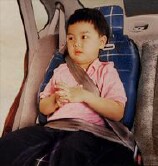
SATURDAY, July 10 (HealthDay News) — Incorrect use of child safety seats is a major reason why car accidents remain the leading cause of disability and death among children in the United States, an expert warns.
Research has shown that seven out of 10 car seats are not installed correctly, Dr. Karen Judy, an associate professor in the pediatrics department at Loyola University Chicago Stritch School of Medicine, noted in a Loyola news release.
She added that the proper use of safety seats is essential for young children.
“If your child weighs less than 80 pounds and is shorter than 57 inches, a seat belt will lay across the child’s neck and belly. In the event of an accident this puts pressure on sensitive areas with the potential for serious injuries, including spinal cord and abdominal injuries or even death. No matter how short the trip, if your child is in the car, he or she should be in a child safety seat,” Judy said in the news release.
To help keep children safe while traveling in a car, Judy offered the following tips:
- Use the correct type of car seat for a child’s age, height and weight. Most infant safety seats only hold up to 22 pounds and should always be used in a rear-facing position. Children in car seats should not face forward until they are older than 1 year and weigh more than 20 pounds. Children should continue using forward-facing car seats until they are older than age 4 years, or weigh more than 40 pounds.
- Children aged 4 to 8 years should use a booster seat and continue to do so until they are at least 4 feet 9 inches or taller, regardless of their age.
- Children younger than 13 years of age should not sit in the front seat because they could be crushed by air bags if they deploy.
- Read the instructions that came with the car seat as well as your vehicle owner’s manual thoroughly before installing the safety seat in the car. Have a professional check to ensure the seat is installed correctly. Your local police station should have information on safety seat inspection sites in your area.
- Never install a safety seat in the front seat of a car.
- When a child is in a safety seat, the harness should be level with the shoulders and the straps should be secure and tight.
- If possible, don’t use a secondhand car seat. If you do, make certain it’s never been in an accident and has all the parts, including instructions. Never use a car seat that’s six or more years old.
“By taking simple but important measures, parents can protect their children from the number one killer in our nation,” Judy stated. She added that “studies have shown that by taking these precautions the likelihood of your child being killed or disabled in a motor vehicle crash decreases significantly. It’s an easy way to save kids’ lives.”
More information
The U.S. National Highway Traffic Safety Administration has more about child vehicle safety.

